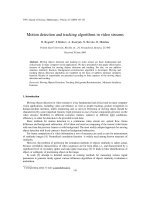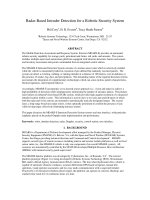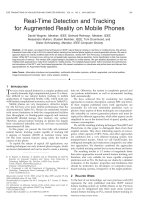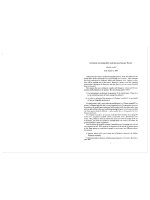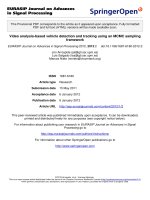kolawole, m. o. (2002). radar systems, peak detection and tracking
Bạn đang xem bản rút gọn của tài liệu. Xem và tải ngay bản đầy đủ của tài liệu tại đây (2.36 MB, 388 trang )
//SYS21///INTEGRAS/B&H/RSP/REVISES_14-12-02/0750657731-PRELIMS.3D ± 1 ± [1±26/26] 19.12.2002
5:19PM
Radar Systems, Peak Detection and Tracking
//SYS21///INTEGRAS/B&H/RSP/REVISES_14-12-02/0750657731-PRELIMS.3D ± 2 ± [1±26/26] 19.12.2002
5:19PM
This book is dedicated to my best friend and my wife,
Dr Marjorie Helen Kolawole.
Your unfailing support has been a constant source of joy and
strength.
You are the loveliest of women.
//SYS21///INTEGRAS/B&H/RSP/REVISES_14-12-02/0750657731-PRELIMS.3D ± 3 ± [1±26/26] 19.12.2002
5:19PM
Radar Systems, Peak
Detection and Tracking
Michael O. Kolawole, PhD
OXFORD AMSTERDAM BOSTON LONDON NEW YORK PARIS
SAN DIEGO SAN FRANCISCO SINGAPORE SYDNEY TOKYO
//SYS21///INTEGRAS/B&H/RSP/REVISES_14-12-02/0750657731-PRELIMS.3D ± 4 ± [1±26/26] 19.12.2002
5:19PM
Newnes
An imprint of Elsevier Science
Linacre House, Jordan Hill, Oxford OX2 8DP
200 Wheeler Road, Burlington, MA 01803
First published 2002
Copyright
#
2002, Michael Kolawole. All rights reserved.
The right of Michael Kolawole to be identified as the author of this work has been
asserted in accordance with the Copyright, Designs and Patents Act 1988
No part of this publication may be reproduced in any material form (including photocopying
or storing in any medium by electronic means and whether or not transiently or incidentally
to some other use of this publication) without the written permission of the copyright holder
except in accordance with the provisions of the Copyright, Designs and Patents Act 1988 or under
the terms of a licence issued by the Copyright Licensing Agency Ltd, 90 Tottenham Court Road,
London, England W1T 4LP. Applications for the copyright holder's written permission
to reproduce any part of this publication should be addressed to the publisher.
British Library Cataloguing in Publication Data
A catalogue record for this book is available from the British Library.
ISBN 0 7506 57731
For information on all Newnes publications
visit our website at www.newnespress.com
Typeset by Integra Software Services Pvt. Ltd, Pondicherry, India
www.integra-india.com
Printed and bound in Great Britain
Preface
Acknowledgements
Untitled
Notations
Part I Radar Systems
1 Essential relational functions
1.1 Fourier analysis
1.2 Discrete Fourier transform
1.3 Other useful functions
1.4 Fast Fourier transform
1.5 Norm of a function
1.6 Summary
Appendix 1A
2 Understanding radar fundamentals
2.1 An overview of radar system
architecture
3 Antenna physics and radar
measurements
3.1 Antenna radiation
3.2 Target measurements
3.3 Summary
Appendix 3A
4 Antenna arrays
4.1 Planar array
4.2 Phase shifter
4.3 Beam steering
4.4 Inter-element spacing
4.5 Pattern multiplication
4.6 Slot antenna array
4.7 Power and time budgets
4.8 Summary
5 The radar equations
5.1 Radar equation for conventional radar
5.2 Target fluctuation models
5.3 Detection probability
5.4 Target detection range in clutter
5.5 Radar equation for laser radar
5.6 Search figure of merit
5.7 Radar equation for secondary radars
5.8 Summary
Appendix 5A Noise in Doppler processing
Part II Ionosphere and HF Skywave
Radar
6 The ionosphere and its effect on HF
skywave propagation
6.1 The admosphere
6.2 The ionosphere
6.3 Summary
7 Skywave radar
7.1 Skywave geometry
7.2 Basic system architecture
7.3 Beamforming
7.4 Radar equation: a discussion
7.5 Applications of skywave radar
7.6 Summary
Part III Peak Detection and Background
Theories
8 Probability theory and distribution
functions
8.1 A basic concept of random variables
8.2 Summary of applicable probability rules
8.3 Probability density function
8.4 Moment, average, variance and
cumulant
8.5 Stationarity and ergodicity
8.6 An overview of probability distributions
8.7 Summary
9 Decision theory
9.1 Tests of significance
9.2 Error probabilities and decision criteria
9.3 Maximum likelihood rule
9.4 Neyman-Pearson rule
9.5 Minimum error probability rule
9.6 Bayes minimum risk rule
9.7 Summary
10 Signal-peak detection
10.1 Signal processing
10.2 Peak detection
10.3 Matched filter
10.4 Summary
Part IV Estimation and Tracking
11 Parameter estimation and filtering
11.1 Basic parameter estimator
11.2 Maximum likelihood estimator
11.3 Estimators a posteriori
11.4 Linear estimators
11.5 Summary
12 Tracking
12.1 Basic tracking process
12.2 Filters for tracking
12.3 Tracking with PDA filter in a cluttered
environment
12.4 Summary
References
Glossary
Index
//SYS21///INTEGRAS/B&H/RSP/REVISES_14-12-02/0750657731-PRELIMS.3D ± 10 ± [1±26/26] 19.12.2002
5:19PM
Preface
This book is written to provide continuity to the reader on how radar
systems work, how the signals captured by the radar receivers are processed,
parameterized and presented for tracking, and how tracking algorithms are
formulated. Continuity is needed because most radar systems books have
been written that concentrate on certain specialized topics assuming a prior
knowledge of the reader to background principles. In most cases extended
references are given to the understanding of the topics in question. This can
be frustrating to practitioners and students sorting through books to under-
stand a simple topic. Hence this book takes a thorough approach to ramp-
ing up the reader in the topical foundations. Advanced topics are certainly
not ignored. Throughout, concepts are developed mostly on an intuitive,
physical basis, with further insight provided through a combination of
applications and performance curves.
The book has been written with science and engineering in mind, so that
it should be more useful to science and communications professionals and
practising electrical and electronic engineers. It could also be used as a text-
book suitable for undergraduate and graduate courses. As a practitioner and
teacher, I am aware of the complexity involved in the presentation of many
technical issues associated with the topic areas. This is the main reason why
the book
.
builds up gradually from a relatively low base for the reader to have a
good grasp of the mathematics, and the physical interpretation of the
mathematics wherever possible before the reader reaches the advanced
topics, which are certainly not ignored but necessary in the formulation of
tracking algorithms;
.
gives sufficient real-life examples for the reader to appreciate the synergy
involved and have a feel for how physical abstractions are converted to
quantifiable, real events or systems;
.
where real-life matters cannot be linked directly to physical derivations,
gives further insight through a combination of applications and perform-
ance curves. In most cases, those seeking qualitative understanding
can skip the mathematics without any loss of continuity. Professionals
//SYS21///INTEGRAS/B&H/RSP/REVISES_14-12-02/0750657731-PRELIMS.3D ± 11 ± [1±26/26] 19.12.2002
5:19PM
in the field would greatly appreciate the background knowledge mathe-
matics, sufficient for them to follow the advanced sections with very little
difficulty;
.
presents a number of new ideas which may deserve further investigation.
In general, readers of this book will gain an understanding of radar systems'
fundamental principles, underlying technologies, architectures, design
constraints and real-world applications. To be able to cover all relevant
grounds, the book contains 12 chapters, divided into four parts. Each part
represents topics of comparable relevance.
Part I contains five chapters. The chapters are structured in a way that
gives the reader a continuum in the understanding of radar systems. Each
chapter is somehow self-sufficient. However, where further knowledge can
be gained, applicable references are given.
Chapter 1 provides the essential functional relations, concepts, and
definitions that are relevant to radar systems' development and analysis
and signal peak detection. This approach is taken to provide the basic
groundwork for other concepts that are developed in subsequent chapters.
The areas covered are sufficiently rich to provide a good understanding of
the subject matter for non-specialists in radar systems and associated signal
processing.
The next four chapters concentrate on radar systems. Discussions on
radar systems evolve from basic concept and gradually increase to a more
complex outlook. The author believes that mastering the fundamentals
permits moving on to more complex concepts without great difficulty. In
so doing, the reader would learn the following:
.
The basic architecture of radar systems, receiver sensitivity analysis, and
data acquisition and/or compression issues as well as the applications of
radar in Chapter 2.
.
Chapter 3 examines the physics of an antenna, which is a major item in
radar systems design. It starts from the perspective of a simple radiator,
the division of radiation field in front of an antenna into quantifiable
regions and further discusses the principle of pulse compression. Pulse
compression allows recognition of closely spaced targets as well as
enabling range measurements when transmitting with signal pulses and
a train of pulses.
.
Chapter 4 shows how the extension of the simple radiator's radiation
property to an array of radiators including slot antennas can achieve
a higher gain as well as the freedom to steer the array antenna in any
preferred direction.
.
Chapter 5 explains how radar equations are developed recognizing the
effect of the environment on the conventional, laser and secondary radar
performance and the detection of targets of variable radar cross-sections
and mobility.
Preface
xi
//SYS21///INTEGRAS/B&H/RSP/REVISES_14-12-02/0750657731-PRELIMS.3D ± 12 ± [1±26/26] 19.12.2002
5:19PM
Part II comprises two chapters: 6 and 7. When a wave traverses the regions
comprising the atmosphere it results in the degradation of signal-target
information due to spatial inhomogeneities that exist and vary continuously
with time in the atmosphere. The spatial variations produce statistical bias
errors, which are an important consideration when formulating and design-
ing a high frequency (HF) skywave radar system. Chapter 6 explains how
these errors are quantified including the polarization rotational effect on the
traversing wave. Chapter 7 explains the design consideration and perform-
ance of the skywave radar.
The issue of what the true nature of data is and what to do with data
acquired by radar becomes relevant after the data, which might have been
corrupted prior to being processed, has been processed. Data processing
involves the transformation of a set of coordinated physical measurements
into decision statistics for some hypotheses. These hypotheses, in the case of
radar, are whether targets with certain characteristics are present with
certain position, speed, and heading attributes. To test the trueness of the
hypotheses requires knowledge of probability and statistical and decision
theory together with those espoused in Chapter 1 ± the reader will therefore
be in a better position to know the other processes involved in signal-peaks
detection. Hence, Part III is structured into three chapters: 8, 9 and 10.
Chapter 8 reviews some of the important properties and definitions of
probability theory and random processes that bear relevance to the succeed-
ing topics in Part IV. By this approach, the author consciously attempts to
reduce complex processes involved in synthesizing radar system signals to
their fundamentals so that their basic principles by which they operate can
be easily identified. The basic principles are further built on in Chapter 12 to
solve more complex, technical tracking problems.
Chapter 9 investigates one type of optimization problem; that is, finding
the system that performs the best, within its certain class, of all possible sys-
tems. The signal-reception problem is decoupled into two distinct domains,
namely detection and estimation. Detection problem forms the central theme
of Chapter 10 while estimation is discussed in Part IV, Chapter 11. Detection
is a process of detecting the presence of a particular signal, among other
candidate signals, in a noisy or cluttered environment.
Part IV contains two chapters ± 11 and 12 ± covering parameter estima-
tion and radar tracking. Estimation is the second type of optimization
problem and exploits the several parallels with the decision theory of
Chapter 9. Three estimation procedures are considered, namely maximum
likelihood, a posteriori, and linear estimation.
Tracking is the central theme of Chapter 12 and it brings to the fore all the
concepts discussed in previous chapters. For example, target tracking now
turns the tentative decision statistics, discussed in Chapters 9 and 11, into
more highly refined decision statistics. The probability theory discussed in
Chapter 8 is expanded on to solve the problem of uncertainty in track
initiation and establishment as well as data association.
xii
Preface
//SYS21///INTEGRAS/B&H/RSP/REVISES_14-12-02/0750657731-PRELIMS.3D ± 13 ± [1±26/26] 19.12.2002
5:19PM
I understand during my years of engineering practice and teaching that
many readers learn more by examples, which I have relied on in explaining
difficult concepts. For those readers wishing to test their level of under-
standing several problems are written at the end of each chapter.
Preface
xiii
//SYS21///INTEGRAS/B&H/RSP/REVISES_14-12-02/0750657731-PRELIMS.3D ± 14 ± [1±26/26] 19.12.2002
5:19PM
Acknowledgements
This book is possible because of my professional colleagues who encouraged
me to write a book that demystifies the complexities associated with radar
systems. To them, I am greatly indebted.
I acknowledge the effort of my colleague Mr John Bombardieri, whose
blend of theoretical and practical insight is reflected in his criticism of this
book in its formative period. I am also grateful to my other very valuable
friend, Professor Ah Chung Tsoi of the University of Wollongong, Wollon-
gong, Australia, for his encouragement. My greatest thanks go to my family,
whose unfailing support has been my constant source of strength, especially
Dr Marjorie Helen Kolawole, my wife, for allowing me to go unhindered to
achieve my goals. My sweet love, my special thanks.
//SYS21///INTEGRAS/B&H/RSP/REVISES_14-12-02/0750657731-PRELIMS.3D ± 15 ± [1±26/26] 19.12.2002
5:19PM
Notations
The symbols have been chosen as carefully as possible to prevent confusion.
In a few instances, the same symbol was used. When this occurs, a clear
distinction is made in their meaning and where used in the text is indicated.
Symbols Meaning
A Current potential in Chapter 3, or fundamental matrix
in Chapter 12
A
c
Clutter illuminated surface area
A
d
Attenuation due to absorption by electromagnetic waves
A
e
Effective aperture area of the receiving antenna
A
eb
Effective aperture area of the beacon antenna
A
L
Insertion loss
A
m
Searched area
A
0
Signal amplitude
A
r
Rain attenuation
A
s
Area to be searched
A
t
Target area
a Proportionality constant, or acceleration in Chapter 12
aa Notation that relates to the radar and vehicle dynamics
a
k
Axial ratio of elliptical polarization
a
n
Fourier series coefficient
B Receiver beamwidth, or Bayes risk in Chapter 9
B
n
Noise bandwidth
B
na
Available bandwidth for integration
B
w
Bandwidth of the radar signal
b Proportionality constant
b
n
Fourier series coefficient
CW Continuous wave
C Speed of light
C
ij
Cost function
C
r
Pulse compression ratio
c
c
Level parameters of clutter model
//SYS21///INTEGRAS/B&H/RSP/REVISES_14-12-02/0750657731-PRELIMS.3D ± 16 ± [1±26/26] 19.12.2002
5:19PM
c
k
Cumulant of the kth order
c
n
Series spectral density
c
rr
Weight modifier for beam shaping operation
cov[ ] Covariance matrix of [ ]
D A layer of the ionosphere used for radio wave
propagation in Chapter 6, or aperture diameter
D
M
A body of data to be encoded
D
L
Laser lens diameter
D
r
Largest dimension of the antenna, or directive gain (also
called directivity)
D
x
Detectability factor
D
y
Dynamic range
d Allowable spacing between array elements in Chapters 4
and 7, or statistical Euclidean distance in Chapter 12
d
max
Maximum spacing between array elements
d
n
Distance between radiators of log periodic antenna
d
u
Duty cycle
d
v
Maximum fraction of the interpulse interval available
for target reception or clear region duty cycle
E Electric charge in Chapter 3, or a layer of the ionosphere
used for radio wave propagation in Chapter 6
E[x(t)] Expectance (or m mean) of the variable x, sampled
at time t
E
o
Amplitude of the plane wave
E
f
, E
y
, E
r
Electric intensity in the f, y, r direction
e
e
Charge of an electron
e
r
Receiver sensitivity
erf(x) Error function of (x)
F Ratio of the resultant field at the target in the presence of
surface reflection coefficient r in Chapter 5, or force
exerted in Chapters 3 and 6
F1, F2 F layers of the ionosphere subdivided into two: F1, F2
F
1
Field pattern of a single point source radiator
F
2
Array factor for the n radiators
F
a
Noise density factor
F
I
Stage noise factor
F
n
Noise density factor
F
k
Discrete form of Fourier series sampler
F
N
Noise figure
FOM Figure of merit
f Frequency
f (y) Pattern factor
f (t) Function of a signal at time t
f
c
Correlation frequency in Chapter 5, or critical frequency
in Chapters 6 and 7
xvi
Notations
//SYS21///INTEGRAS/B&H/RSP/REVISES_14-12-02/0750657731-PRELIMS.3D ± 17 ± [1±26/26] 19.12.2002
5:19PM
f
d
Doppler shift
f
0
Nyquist frequency or folding frequency (in Chapter 1),
cut-off frequency (in Chapter 2), or sampling frequency
foE, foF1, foF2 Frequency of maximum response at E, F1, F2 layers
f
p
Plasma frequency
f
x
(x
1
, x
2
, , x
n
) Joint density function of, or probability distribution
function of, a set of data x
1
, x
2
, x
n
G Gain
G
b
Gain of the beacon antenna
G
i
Stage i gain or antenna gain of the interrogating radar
G
r
Antenna gain of receiving radar
G
t
Antenna gain of transmitting radar
g Gravitational constant
gD Number of sunspot group
g
t
Gating threshold
H Magnetic field vector
H Entropy in Chapter 2, magnitude of the magnetic field
intensity at any point on the earth in Chapter 6, or
measurement transition matrix in Chapters 11 and 12
^
H Scaled, or normalized height
H
op
Transfer function of an impulse h
op
H
z
, H
y
Magnetic field intensity of the wave along z, y direction
h Planck's constant, or height of a reflecting layer
in the ionosphere in Chapter 6
h
a
Antenna height above datum
h
c
Height of the radar antenna above the clutter surface
h
max
Height of maximum ionization density
h
op
Impulse of the optimum linear filter
h
mF2
Height of the peak density of the F2 layer
h
t
Target height above datum
h
v
Virtual height
I Alternating current
IF Intermediate frequency
I
F2
Ionospheric index
IFF Identify friendly or foe
IP
n
Intercept point of the nth order
I
0
Modified Bessel function of first kind, zero order in
Chapters 1 and 5, or amplitude of the alternating
current in Chapter 3
i Total current density
i
c
Convectional current density
i
D
Displacement current density
J Jacobian function
K Scale or correction factor K to effect the conversion to
the scale originated by Wolf for sunspot number
Notations
xvii
//SYS21///INTEGRAS/B&H/RSP/REVISES_14-12-02/0750657731-PRELIMS.3D ± 18 ± [1±26/26] 19.12.2002
5:19PM
K
a
Acceleration steady-state variance reduction ratio
K
v
Velocity steady-state variance reduction ratio
K
x
Position steady-state variance reduction ratio
k Boltzmann's constant
k
w
Index of an elliptically polarized antenna
k
d
Wind direction adjustment factor
k
e
Number of degrees of freedom describing a target
function
k
g
Grazing angle adjustment factor
k
p
Polarization adjustment factor
k
s
Sea state adjustment factor
k
y
Aperture illumination constant
L Path length of the intervening rain in Chapter 5,
or likelihood function in Chapter 11
L
f
Steady-state apparent fluctuation loss
L
p
A category of norms in Chapter 1, or polarization loss
between an antenna elliptically and linearly polarized in
Chapter 5
L
pi
Propagation losses in clutter patches
L
n
Pattern constant
L
s
System loss
L
tot
Total losses
l Separation distance between the electric charges
l
i
The ith length of the periodic antenna element
M Moment of the dipole in Chapter 3, or complex index of
refraction in Chapter 6
m out of nmpeaks selected out of n detections
m
e
Mass of an electron
m
k
kth moment
N Iteration limit number
N
amb
Number of ambiguities that can be folded, or mapped,
into a particular cell
N
B
Background interference
N
c
Number of parallel channels
N
e
Electron density
N
i
Laser radar noise power
N
mF2
F2-peak density
N
n
Number of densities of neutral particles
N
Æ
Number of densities of positive and negative ions
N
0
Total noise at the output of the receiver or maximum
electron density in Chapter 6
N
p
Number of samples coherently processed
N
thermal
Thermal noise or Johnson noise
N
2
Molecular nitrogen
N(m, s
2
) Normal distribution of mean m and variance s
2
xviii
Notations
//SYS21///INTEGRAS/B&H/RSP/REVISES_14-12-02/0750657731-PRELIMS.3D ± 19 ± [1±26/26] 19.12.2002
5:19PM
n Index of refraction in Chapter 6, or iteration limit in
other chapters
n
b
Number of beams
n
c
Number of cells to be searched
n
d
Number of Doppler filters
n
e
Number of cells or number of independent pulses
integrated during N-pulse transmission
n
o
Refractive index of the ordinary wave in Chapter 6
n
x
Refractive index of the extraordinary wave in
Chapter 6
n
p
Number of photoelectron emissions
O
2
Molecular oxygen
P Power radiated by a dipole in Chapter 3, or covariance
matrix in Chapters 11 and 12
P Error covariance vector
P(x) Probability of variable x
PDA Probabilistic data association
P
b
Power output of the beacon antenna
P
c
Clutter power
P
d
Probability of detection
P
e
Probability of error
P
fa
Probability of false alarm
P
g
Gate probability
P
o
Probability that a target can be observed
P
r
Received signal power
P
t
Transmit power of the interrogating radar
P
o,x
Polarization of the ordinary `o', and extraordinary
`x' wave
PRI Pulse repetition interval
Pr{} Probability of {}
P(x jy) Probability of x given y
p(x) Probability density function of x
p(xy) Joint probability density function of two variables
x and y
pdf Probability density function
Q Obliquity factor in Chapter 6, number of channels
occupied by signals greater than specified threshold in
Chapter 7, or noise covariance matrix in Chapters 11
and 12
q Oscillating charge
q, Àq Positive, negative point charge
R Limit of field boundary
R Measurement noise covariance vector
R Generally range or noise covariance matrix in Chapters
11 and 12
Notations
xix
//SYS21///INTEGRAS/B&H/RSP/REVISES_14-12-02/0750657731-PRELIMS.3D ± 20 ± [1±26/26] 19.12.2002
5:19PM
R Average range
RF Radio frequency
R
012
Direct radar range
R
12
Yearly smoothed relative sunspot number
R
c
Clutter range, being the distance from the radar
to the centre range gate
R
eq
System equivalent impedance
R
n
Sunspots occurrence measurement
R
rad
Radiation resistance
R
un
Unambiguous range
R
xy
, R
xx
Cross-correlation of the signals x and y, autocorrelation
function of same signal x
_
r Rate of change, or first derivative, of r (range)
r, r_ Second, third derivative of r
r
H
Elliptical distance observed at a point not at the equator
r
e
Radius of the earth at the equator
r
i
Target position in the ith scan
r
m
Measured range
r
p
Predicted range
r
r
Rain rate
S Sea state index in Chapter 5, received signal power in
Chapter 7, or residual covariance matrix in Chapters 11
and 12
S
bmin
Minimum detectable signal of the beacon receiver
S
i
Radar input signal
S
min
Minimum detectable signal of the radar receiver
S/N Signal-to-noise ratio
S
o
Signal power at the output of the receiver
S
T
Target power
s Number of observed individual sunspots
s
i
Matched filter input signal
s
o
Matched filter output response
T Record length in Chapter 1, data interval (sampling period)
in Chapters 11 and 12, or temperature elsewhere
T
D
Duration of waveform
T
e
Temperature of electron ions
T
f
Frame time
T
i
Integration time
T
n
Temperature of neutral particle
T
0
Ideal standard temperature
T
p
Pulse repetition period
T
s
Dwell time
T
t
Track
tr{.} Trace of {.}
t
c
Target correlation time
xx
Notations
//SYS21///INTEGRAS/B&H/RSP/REVISES_14-12-02/0750657731-PRELIMS.3D ± 21 ± [1±26/26] 19.12.2002
5:19PM
t
0
Measurement interval time or time dwelled on target
t
s
Time required by the laser radar to search a field (also
called laser frame time)
UV Ultraviolet ray
u Plant noise vector
u Shape parameter of clutter model
V Electric potential between two charges
V
c
Rain clutter volume
V
cc
Proportion of clutter in validation volume
V
p
Propagation wave phase velocity
V
g
Propagation wave group velocity
V
t
Proportion of target peaks in validation volume
V
v
Volume of the validation region
^
v(k) Smoothed velocity
v Measurement noise vector
v Effective angular collision frequency in Chapter 6, or
velocity in Chapter 12
v
H
n
, v
H
Æ
, v
H
Æn
, v
H
ÆÇ
Collision frequencies of electrons with neutral particles,
electrons with ions, ions with neutral particles, and ions
with ions respectively
v(f
b
) Orthogonal beams in f domain
v
e
Clutter amplitude or threshold voltage
w Weight vector
W Weight factor
w
k
Window function
w
p
Complex weighting on the received data from pth
element of the array antenna that is beamformed
X
HT
r
, X
HHT
r
Test signal distribution across the receiver inputs,
response within the processor
x
p
Received data from pth element of the array antenna
that is beamformed in Chapter 7, or forecast (predicted)
position in Chapter 12
Y
n
Day number starting on 1 January
~
y Innovation or residual vector
^
y Estimate of y
y(k) Measurement recorded on the k radar scans
y
mF2
Semi thickness associated with height of the peak density
of the F2 layer
y
k
Beam output
Z
d
Impedance of the dipole
Z
s
Impedance of the complementary slot
z(k) Observations on the k radar scans
a Reference part of the propagation coefficient in Chapter
6, or position damping factor in Chapter 12
a
g
Apparent elevation angle
Notations
xxi
//SYS21///INTEGRAS/B&H/RSP/REVISES_14-12-02/0750657731-PRELIMS.3D ± 22 ± [1±26/26] 19.12.2002
5:19PM
a
m
Signal modulation factor
a
n
Neuvy constant
a
0
Apparent ionospheric elevation angle or threshold value
in Chapter 9 for Neyman±Pearson rule
a
0
Electron density gradient
ab Two-point extrapolator filter
abg Three-point extrapolator filter
b Phase angle or the quadrature component of the
propagation coefficient, or velocity damping factor
in Chapter 12
b
i
Event probability
b
t
Geometric spacing between adjacent elements of log
period antenna
b
n
Neuvy constant
x Sea reflectivity
w
p
Angle between linear polarization and the ellipse's major
axis
x
ref
Reference reflectivity
w(t, f
d
) Two-dimensional function in delay, t, and Doppler shift,
f
d
; called uncertainty function, correlation function, or
an ambiguity function
w
2
n
Chi-squared distribution
d Delta function, or solar declination in Chapter 6
d
kj
Kronecker symbol
dd Phase progression angle
Df
d
Doppler shift
D Proportionality constant of uniformly distributed
random disturbances
Da Refraction error angle
Da
ref
Measurement elevation-angle error, or refraction-angle
error
Da
T
Angle between the ray path and the direct path at the
target location
Df Phase caused by path difference
Df
0
The phase difference of direct and reflected fields
reaching the target of equal intensity
D
f
Filter spacing
DH Vertical extent of the beam in the rain or height of the
radar resolution cells (whichever is lesser)
D
h
Hour angle of the sun measured westward from
apparent noon
D
lat
Geographic latitude
D
gla
Geomagnetic latitude
Dn Difference in the refractive index of two magneto-ionic
components
xxii
Notations
//SYS21///INTEGRAS/B&H/RSP/REVISES_14-12-02/0750657731-PRELIMS.3D ± 23 ± [1±26/26] 19.12.2002
5:19PM
Dy Width of transmitter beam
D
_
R
min
, D
R
min
Nominal range-rate resolution, nominal resolution in
acceleration
DR Time delay or range error
DR
d
Path difference between direct and reflected waves
DS Difference between the required signal level and that of
undesired distortion
Dt Steering time delay
DV Error introduced in the target Doppler velocity
Dx Pulse width spacing
Dx
if
Range extent at a particular operating frequency
Dw Width of the illuminated area
J Characteristic function of a random variable
P Error
e
r
Relative permittivity
e
0
Permittivity of free space
z Solar zenith angle
f Angle between the surface normal and incident radar
signal (for laser radar in Chapter 5), or total angular
excursion
F
0
Average noise floor
G Gamma function, or functional form in Chapter 9
G
D
Input reflection coefficient of the antenna
Z Detector quantum (or optical) efficiency in Chapter 5, or
apex angle of log period antenna in Chapter 7
Z
0
Characteristic impedance of free space
Z
v
Rain reflectivity
Z
v
Mean rain reflectivity for each cell
k Proportionality constant in determining rain reflectivity
in Chapter 5, or weighting factor in Chapters 11 and 12
l Wavelength
l
Ã
Radian length
l
c
Spatial density of false (clutter) measurement
l
D
Characteristic length or Debye length
l
D
Manoeuvre correlation coefficient
l
t
Spatial density of true target measurement
l
v
Approximate spatial density of false and target
measurements
g Proportionality constant for sea and land reflectivity in
Chapter 5, propagation coefficient in Chapter 6, or
acceleration damping factor in Chapter 12
g
a
Decision threshold
g
fa
Desired threshold or biased value for nominally
accepted probability of false alarm
g
f
Phase angle of the reflection coefficient
Notations
xxiii
//SYS21///INTEGRAS/B&H/RSP/REVISES_14-12-02/0750657731-PRELIMS.3D ± 24 ± [1±26/26] 19.12.2002
5:19PM
x Solar zenith angle in Chapter 7 or significance test level
in Chapter 9
m Arithmetic mean
m
t
, m
c
Target, clutter distribution function
y Antenna elevation angle
_
y,
y First, second derivative of y (bearing)
y
a
Azimuth beamwidth, or antenna elevation angle
in Chapter 5
y
BW
Beamwidth (laser radar)
y
e
Antenna elevation beamwidth
y
H
Horizontal beamwidth
y
0
Scanning or steering angle
y
v
Vertical beamwidth
y
a
Depression angle
y
ag
Level parameters of clutter model
y
t
Target elevation angle
s Target radar cross-section in Chapter 5, or conductivity
in Chapter 6
s
c
Land, or sea, clutter cross-section
s
0
Land, or sea, reflectivity
s
x
Standard deviation of signal/data x
s
2
x
Second-order moment, or variance, of signal/data x
s
z
Root-mean-square of wave height
s
2
m
Predicted measurement variance
s
2
x
s
Position measurement variance
s
2
vr
Measurement noise variance in range
s
2
vy
Measurement noise variance in bearing
s
2
ac
Variance of target acceleration
r Surface reflectivity or surface reflection coefficient
t Pulse width, delay in range or time required for changes
at the dipole to travel a distance in Chapter 3, or
log-periodic antennas' geometric ratio in Chapter 7
t
fa
Average time between false target peaks
L Log normal distribution-model constant, or likelihood
test in Chapter 9
Union
c Total phase difference of the radiating fields from
the adjacent elements in Chapter 4, grazing angle
in Chapter 5, or orientation of the target velocity
in Chapter 6
c
t
Transitional angle beyond which an adjustment factor
is applied
c
0
Mean value of Rayleigh component of clutter
C
m
, C
p
Measured, predicted bearing
O Sample space
xxiv
Notations
//SYS21///INTEGRAS/B&H/RSP/REVISES_14-12-02/0750657731-PRELIMS.3D ± 25 ± [1±26/26] 19.12.2002
5:19PM
O
bs
Laser radar search solid angle
O
c
Critical region
y Variable bearing
_
y Variable bearing rate
y
m
Measured bearing
y
p
Predicted bearing
(y
0
,r
0
) Cartesian coordinate of point of intersection
Y
i
Event density function
W Target speed
n Gate size
L
Ã
Modifying function
Convolution
Notations
xxv
//SYS21///INTEGRAS/B&H/RSP/REVISES_14-12-02/0750657731-PRELIMS.3D ± 26 ± [1±26/26] 19.12.2002
5:19PM
//SYS21///INTEGRAS/B&H/RSP/REVISES_14-12-02/0750657731-CH001.3D ± 1 ± [1±36/36] 18.12.2002 9:09PM
Part I
Radar Systems
This part contains five chapters. The chapters are structured in a way that
provides continuity to the reader in the understanding of radar systems.
Each chapter is somehow self-sufficient. However, where further knowledge
can be gained, applicable references are given.
Chapter 1 provides the essential functional relations, concepts, and defin-
itions that are relevant to radar system's development and analysis and signal
peak detection. This approach is taken to provide the basic groundwork for
other concepts that are developed in subsequent chapters. The areas covered
are sufficiently rich to provide a good understanding of the subject matter for
non-specialists in radar systems and associated signal processing.
The next four chapters concentrate on radar systems. Discussions on
radar systems evolve from a basic concept and gradually increase to a more
complex outlook. The author believes that mastering the basic fundamentals
permits moving on to more complex concepts without great difficulty. In
so doing, the reader would learn:
.
the basic architecture of radar systems, receiver sensitivity analysis, and
data acquisition and/or compression issues as well as what radars are used
for in Chapter 2;
.
the physics of an antenna, which is a major item in radar systems design,
from the perspective of a simple radiator, the division of radiation field in
front of an antenna into quantifiable regions, the principle of pulse com-
pression that allows recognition of closely spaced targets, as well as range
measurements for signal pulse and train pulses in Chapter 3;
.
that by extending the simple radiator's radiation property to an array of
radiators including slot antennas, a higher gain can be achieved, and the
array can be steered in any preferred direction in Chapter 4;
.
how the radar equations are developed recognizing the effect of the environ-
ment on the conventional, laser and secondary radar performance and detec-
tion of targets of variable radar cross-sections and mobility in Chapter 5.
I understand during my years of engineering practice and teaching that
many readers learn more by examples, which I have relied on in explaining
difficult concepts. For those readers wishing to test their level of under-
standing several problems are written at the end of each chapter.
